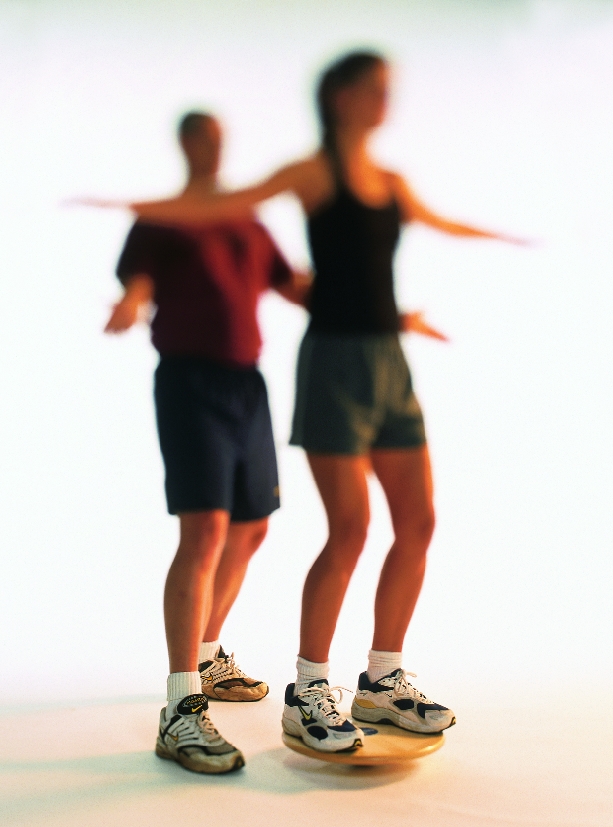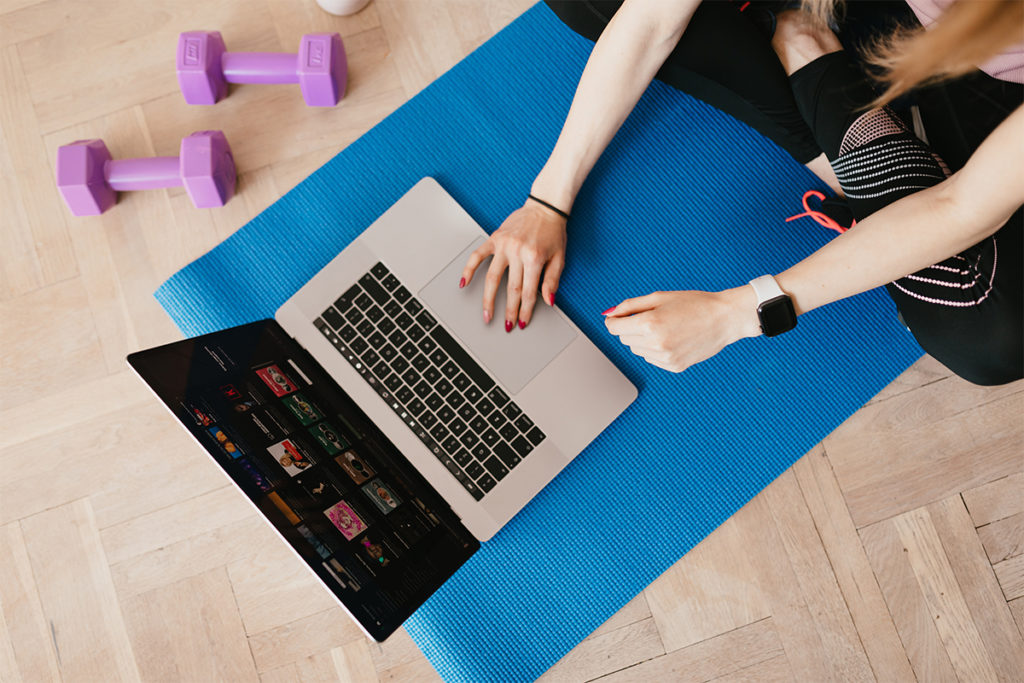How to Improve Proprioception
Focus on the lower body to train balance.

It seems that everywhere you go these days, people are talking about core stabilization or stability training. While fitness professionals and consumers are captivated by this new “core craze,” the main focus of this type of training is really proprioception. Improving proprioception requires progression, just as improving strength or endurance does. You would not tell a client to bench-press 300 pounds on his first day of weight training, nor would you ask him to complete a marathon after his first trial run. Yet many fitness professionals don’t think twice about asking a client to jump headlong into core-training classes that require proprioceptive skills. But think twice they should, as you will learn from this primer on proprioception!
Proprioception is the body’s ability to transmit a sense of position, analyze that information and react (consciously or unconsciously) to the stimulation with the proper movement (Houglum 2001). Put simply, it is the ability to know where a body part is without having to look. Proprioception allows you to scratch your head without looking in the mirror or walk up a flight of stairs without having to peer at each stair.
Taken as a whole, proprioception includes balance, coordination and agility because the body’s proprioceptors control all these factors. Proprioceptors consist of both sensory and motor nerves that send and receive impulses to and from the central nervous system from stimuli within the skin, muscles, joints and tendons (Houglum 2001). These impulses transmit vital information, such as the amount of tension in a given muscle and the relative position of a body part during a given movement.
By improving their proprioception, clients can gain the balance skills necessary to maintain stability; hone their agility so they can quickly change direction when necessary; and fine-tune coordination skills so they can perform physical activities accurately and consistently. Proprioception exercises reduce the risk of injury by teaching the body to react appropriately to sudden changes in the environment. A good sense of proprioception is vital for many fitness activities, especially some of the more advanced core-training classes currently attracting large numbers of clients.
More equipment designed to improve proprioception is on the market today than ever before. There are balance boards, stability trainers, Bongo™ Boards and BOSU® Balance Trainers, just to name a few. Fitness professionals have only to do a quick search on the Internet to find the wide array of products available from various companies. (See “Resources” on page 38 for contact information for some of the products cited in this article.)
However, the most important piece of equipment you need to train proprioception is something you already have: the floor. When starting proprioception training, all clients should begin on a solid, flat surface. Any floor surface will work; just make sure each client has plenty of room to move about freely.
While many companies offer excellent proprioception training devices, I have found that Thera-Band® Stability Trainers are particularly well suited for progressing beginners from performing exercises on the floor to learning how to balance on equipment. These trainers are essentially large pieces of foam, flat on the bottom and a bit curved on the top, but still easy for novices to stand on. Thera-Band trainers are available in two different models: green for intermediate-level clients, blue for advanced students. You can use these trainers to increase the difficulty of proprioception exercises as clients progress.
Fitter Inc. also has a large selection of products available at reasonable prices. The company offers both balance boards and the Bongo Board. Some of the balance boards are adjustable, making it quick and easy to increase the level of difficulty. And while the Bongo Board is more challenging and designed for advanced students, with proper instruction it can be fun to use.
The BOSU Balance Trainer is one of the most versatile pieces of equipment on the market today. Essentially half a ball mounted on a platform, the product can be adjusted to different degrees of firmness. BOSU stands for “Both Sides Up.” The beauty of the BOSU is that you can use the flat surface as either the top or the bottom, depending on the level of difficulty needed for the exercise being performed.
For a look at how group fitness instructors and personal fitness trainers are using today’s balance equipment in innovative ways, see “Update on Today’s Balance Equipment” on page 18.
Proprioception Exercises
When planning proprioception exercises for a particular client, it is just as important to consider the client’s baseline level of skill as it is when designing a flexibility, strength or endurance program. There is no specific test for proprioception as there is for cardiovascular endurance or muscle strength. However, there is a proper progression to follow, starting with static balance activities, progressing to dynamic balance activities and finally advancing to coordination and agility training.
Your clients can perform static balance activities on the floor or using several different types of equipment, such as stability trainers, balance boards, BOSU Balance Trainers or Bongo Boards, either alone or in tandem with more conventional equipment like resistance bands and weighted balls.
You can both evaluate and train proprioception skills using the following activities. If a client can perform an activity properly for the time specified, she can move ahead to the next movement. If not, she needs to repeat the activity until she can do it properly and feels comfortable moving on.
ON THE FLOOR
The most basic activity you can use to determine a client’s level of proprioception is the tandem stance balance. Have your client stand on a level floor surface with one foot in front of
the other, heel to toe. Arms are at sides or raised—whichever is easier. He should be able to stand still in this position for 30 seconds with his eyes open. Next, have the client close his eyes and stand still in the same position for 30 seconds.
The stork stance is also a good test of basic proprioception skills. Have the client stand still on one leg for 30 seconds with both eyes open and arms at his sides or raised, without allowing the elevated foot to touch the ground. Once he can accomplish this, have him close his eyes while maintaining the same position and stand still for another 30 seconds.
STABILITY TRAINER
After a client can do the stork stance with eyes closed while standing on the floor, it is time to move on to an unstable surface. I have found that the Thera-Band Stability Trainer is an effective tool for this purpose. When using this equipment, first have the client repeat both parts of the stork stance. Once he can do this correctly, he can begin doing static balance exercises on the stability trainer. Here are just a few examples:
- calf-raises
- hip abduction
- hip flexion
- mini-squats
- hip extension
- lunges
- hip adduction
For some of these proprioception exercises, such as calf-raises, the client can advance to using one foot once he has mastered the activity using both feet. Because the Thera-Band Stability Trainer is available in different models, you can progress activities in the following order of difficulty: green model (intermediate) to blue model (advanced) to 2 green models stacked together to 2 blue models stacked together. You can also increase resistance by adding a resistance band to any of these exercises.
BALANCE FOR A WOBBLE BOARD
A balance or wobble board is also effective for static balance training. In the beginning, have the client simply stand on the balance or wobble board using both feet. Once your client is comfortable with this exercise, she can begin learning to balance on the balance board using just one foot.
To further increase the level of difficulty, add a distracting activity, such as a game of catch (see below). For some clients, just having an ongoing conversation while performing simple balance activities on the board will provide enough of a distraction. You can also apply this type of distraction when a client is working on the floor or using a stability trainer. Whichever device you use, the goal is to focus the client’s attention on something other than the act of balancing.
WEIGHTED BALL
To increase the difficulty of static balance activities, either on the floor or on balance equipment, you can also use a weighted ball, such as a medicine ball. Play a game of catch with your client, or have her continually move the ball from one part of her body to another. She can also try these movements:
- moving the ball from left to right using both hands while twisting her trunk
- switching the ball from one hand to the other at the midline of her body
The client can perform movements with the ball in any direction (e.g., diagonally or in a circle). To make movements more challenging, increase the ball’s weight or change the speed of the movements. The key here is to be creative; remember that as long as the client is moving, the level of difficulty will increase.
BOSU BALANCE TRAINER
Any of the static balance exercises described above can also be performed on the BOSU Balance Trainer. In fact, one of the features of the BOSU is that its configuration allows you to change the degree of difficulty by simply inflating or deflating the equipment.
The BOSU is also an advanced tool for positioning clients in sport-specific positions. For example, let’s say one of your clients is a tennis player. You can have him stand on the BOSU on the balls of both feet with hips and knees flexed, starting with eyes open, then with eyes closed, for a minimum of 30 seconds. To progress tennis-specific proprioception training, have the client practice backhand shots and serves using a racquet while standing on the BOSU. A golfer can practice swings on the BOSU, with or without a golf club.
BONGO BOARD
The most advanced piece of equipment for static balance training is the Bongo Board. When a client uses this equipment for any of the activities described earlier, you must act as a spotter. It generally takes an adult several sessions to master standing on the Bongo Board, so be patient. Encourage the client to keep trying and not be disheartened when learning to use this valuable piece of equipment.
Once a client has mastered static balance, she can progress to dynamic balance activities. These include sport-specific activities, such as lateral movements, running and backward movements.
As with static balance training, remember to start simple and slowly increase the complexity. All movements should be slow in the beginning and increase in speed when progression is appropriate. Never overestimate a client’s skill level when increasing the level of difficulty!
To begin dynamic balance activities, find a flat, soft surface, such as a local football field or convenient grassy area. Have the client run a specific distance forward and then the same distance backward. Again, the first step in dynamic balance training is to master proper form, not speed. To make activities more difficult as the client progresses, increase the speed and/or distance. Then move on to performing the activities on the more advanced types of equipment described earlier.
Recovery time for dynamic balance exercises can vary. I like to start with 1-minute rests between sets. As my clients progress, I decrease the recovery time between sets to make the exercises harder.
Advanced proprioception activities are designed to improve agility and coordination skills. These activities include pivoting, twisting, cutting and jumping.
With the exception of jumping, a client should perform all of these activities on the floor. Jumping can take place either on the floor or on plyometric boxes. I prefer to start agility and coordination training with pivoting, twisting and cutting activities (always done on both feet) and then progress to jumping. Your client should begin each jumping activity using both legs and can then progress to using one leg once he has mastered the skill.
With agility and coordination activities, focus on mimicking movements essential to the client’s sport of choice. For example, for a client who plays in a soccer league, incorporate more side-to-side movements and kicking activities than you would for someone who regularly runs 5K races. If the client is a golfer, focus on how to maintain balance while moving the upper extremities. With a recreational basketball player, spend more time on jumping and on mastering the art of sudden stops and starts.
When designing any proprioception training program, you need to consider the client’s age, body weight, level of competition and footwear.
During proprioceptive activities, children under the age of 16 are at a higher risk of injury than adults because their central nervous systems are not fully developed; information is not transmitted quickly enough to provide the necessary safeguards against excessive body stresses. Older adults have a similar problem because message transmissions to and from the central nervous system tend to slow with age. Both children and seniors are also more prone to injuries during proprioception training because they tend to have less muscular strength than adults.
Body weight is another concern, especially when implementing dynamic balance activities. The more a client weighs, the less he may be able to do. The stress placed on joints during some dynamic balance or agility/coordination movements may be too much for some clients. For example, a client who weighs 250 pounds may be able to perform a vertical jump only five times in 30 seconds, whereas a 120-pound client may be able to do 20 jumps in the same amount of time. The intensity and progression of more advanced activities must be based on each client’s unique abilities.
When choosing how to progress proprioception activities, you also need to address the level at which a client participates in a given sport. For example, the goals of a competitive runner will be very different from the goals of a recreational runner. And, of course, you would not expect a 55-year-old novice exerciser to be at the same fitness level as an 18-year-old gymnast.
Footwear worn during proprioception training is also important. To prevent injuries, ensure that each client wears the appropriate amount of support and cushion for the activity being performed. Although a client should be barefoot for exercises like the stork stance, proper footwear is crucial for advanced activities such as running and jumping. Proper footwear means shoes
- are in good condition
- are not excessively worn
- fit properly
- offer appropriate support and cushioning
- are laced correctly
Correct technique is essential when performing all of the proprioceptive exercises described in this article. Clients must maintain good postural alignment during each movement and should not be allowed to compensate using other parts of the body. For example, when a client is performing the stork stance, ensure that she is standing up straight and not leaning to either side. When teaching proper landing technique during jumping movements, stress the need to land on the midfoot, not on the heels or toes.
If at any time a client cannot perform an activity using proper technique, you must immediately reduce the difficulty of the activity until you reach a level she can perform correctly. Allowing a client to continue with improper form will increase her chance of injury and decrease her odds of succeeding with the overall training program.
Include proprioception exercises at the beginning of the client’s training session, before fatigue has set in. The time to perform these exercises is after the warm-up, but before cardio and/or strength training. As fatigue increases, so does the risk of injury—especially when you are intensifying the level of difficulty. That said, it is acceptable to include a few simple static balance exercises, such as the stork stance, during the cool-down period. However, dynamic balance and agility/coordination activities should not be performed that late in the training session.
Although improving proprioception helps reduce the risk of injury, there are instances when performing some of the activities described here may actually cause more harm than good. Acute inflammation and postoperative conditions are two common and valid reasons why certain clients should avoid proprioceptive exercises.
Another potential contraindication is joint instability. Before a client with this condition can begin proprioception exercises, he may need to do resistance and range-of-motion training to strengthen the structures surrounding the affected joint. Of course, this will depend on the location of the joint in question. For example, an instability at the shoulder joint would not prevent him from working on lower-extremity proprioception training, whereas an ankle instability obviously would.
With proprioception training, as with any other kind of physical training program, you must know your limitations as a fitness professional. Don’t hesitate to refer a client to an allied health care professional if the client needs specialized attention that is outside your scope of practice. It’s also vital to consider the limitations of the particular client. As mentioned earlier, a client who lacks good proprioception should be advised against participating in group fitness classes like advanced core training, which requires a high level of skill.
Although there are certain contraindications to consider, properly executed proprioceptive training can improve a client’s skill level and ultimately reduce the risk of future injuries. Remember to start the training with simple exercises and increase the complexity as proprioception improves. To increase complexity, change variables such as the surface used; the distance covered; the duration of the activity; or the weight of the objects used to distract the client. Above all, be creative and have fun with these proprioception exercises.
 Have a question about proprioception? Ask it here.
Have a question about proprioception? Ask it here.
References
Houglum, P.A. 2001. Therapeutic Exercise for Athletic Injuries. Champaign, IL: Human Kinetics.




